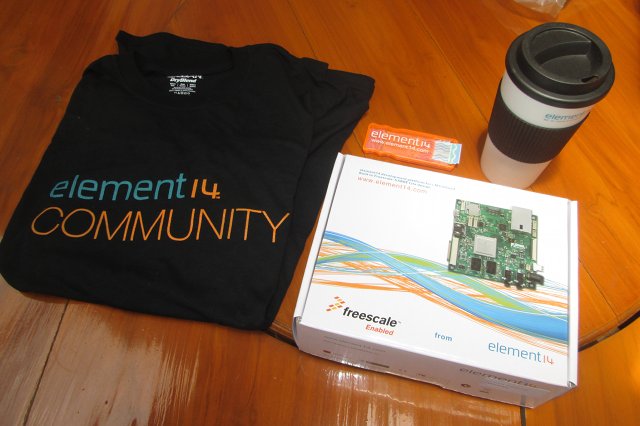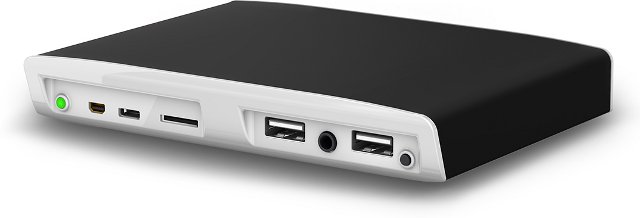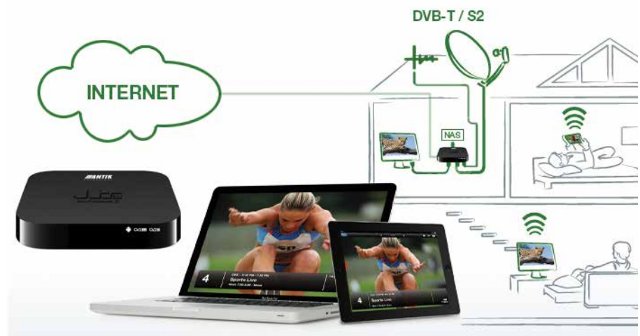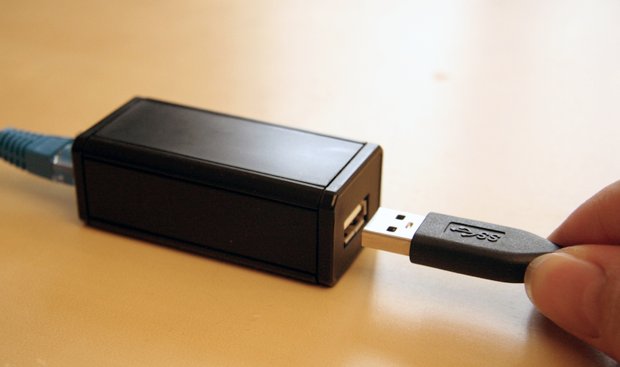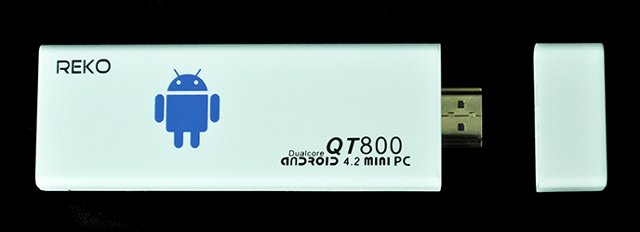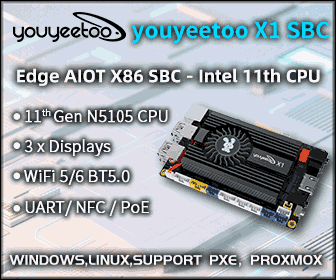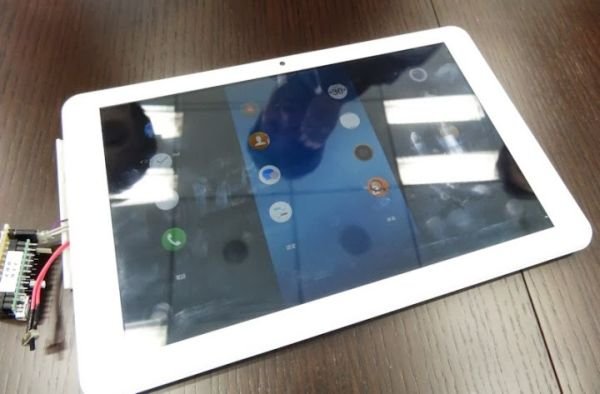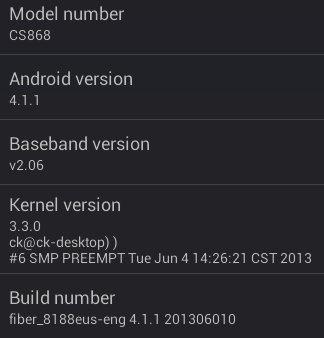Freescale SABRE Lite is a development board powered by i.MX6 Quad processor with 1GB RAM, SATA, GbE Ethernet, and more. You can get SABRE Lite specifications in my first post about the board. I recently participated in Element14’s “brainteaser” competition for the 4th birthday of their community, where the company offered 9 SABRE Lite development kit to randomly selected participants, and I got lucky. The board can be purchased for $179 from Element14 (MCIMX6Q-SL). I’ll start by showing what in the package, followed by a side-by-side comparison with Wandboard Quad, and show how to getting started by following the Quick Start Guide provided with the board. SABRE Lite i.MX6 Development Kit Unboxing I received the board about 5 days after I provided my address in a large staple carton box with a few goodies. Beside SABRE Lite devkit, the package comes with Element14’s T-Shirt (not my size), double walled tumbler, […]
$99 (and up) Compulab Utilite ARM based Computer Runs Ubuntu or Android
If you’re ready to tinker it’s possible to run Linux in one of the low cost ARM based set-top boxes or mini PCs currently available, although if you need Linux with 3D acceleration and video playback, your only realistic option is to go with solutions based on Freescale i.MX6. Compulab has been developing a mini desktop computer based on Freescale i.MX6 Solo, Dual or Quad that will run either Ubuntu or Android, so you don’t need to mess around to run Ubuntu on cheap ARM hardware. The device is expected to sell for $99 and up starting in August according to Fanlesstech. Compulab Utilite will have the following specifications: SoC – Freescale i.MX6 single / dual / quad core Cortex-A9 up to 1.2GHz, with Vivante GPU, and Video Processing Unit supporting multi-stream 1080p H.264, VC1, RV10, DivX HW decoding System Memory – Up to 4GB DDR3-1066 Storage – 1MB SPI […]
Juice Extreme 2 Android TV Home Gateway Features 4 DVB Tuners for Multiscreen Support
Antik Technology, a Slovakia based company, has developed a Android set-top-box powered by STMicro StiH416 SoC. I wrote about the StiH416 development platform previously, and although it’s just a dual core Cortex A9 SoC, its video capabilities are impressive as it supports multiple simultaneous video decoding streams. The set-top box called Juice Extreme 2 leverages those capabilities with 4 DVB tuners (DVB-T or DVB-S2) that provide four different streams, and transcode them, to all video playback devices around your home such as TV, PC, tablet and smartphones, or record them to an internal SATA drive. JUICE EXTREME 2 key features: SoC – STMicro STiH416 (Orly) dual core Cortex A9 @ 1.2 GHz + ARM Mali 400MP4 GPU System Memory – 2 GB DDR3 Storage – 1 GB Flash + internal SATA connector + SD card slot Video: Quadruple DVB Tunner CVBS/Y Pb Pr (3.5mm jack) Tuner board connector RF IN/OUT […]
$79 Plug Makes Creating Your Own Cloud Easy
The “Plug” is a device with an Ethernet connection, and a USB port that allows you to connect up to 8 USB drives, and access those in a unified fashion from all your devices. It’s a bit like dropbox, except you are in charge, and the price per GB is much cheaper than cloud services. The Cloud Guys have launched a kickstarter campaign that has already received over $220,000 in pledges after just over two days. The Plug technical specifications are as follows: OpenWRT based Embedded Linux x86 compatible processor Port for your hard drive – USB 2.0 Port for Internet – Ethernet port 10/100 Mbps Average transfer speed: 30 Mbps Supported file systems: NTFS, HFS+, Ext3/Ext4, FAT32 Number of drives supported (using an external USB hub): 8 LED Display: Power/ Action Dimensions – 270mm (W) x 110mm (D) x 20mm (H) (This must be wrong as it seems way […]
Reko QT800 mini PC Based on AllWinner A20 Comes with Dual Band 300Mbps Wi-Fi (Maybe)
In an HDMI TV stick market now dominated by Rockchip RK3066 and RK3188 based devices, Reko QT800 is one of the rare AllWinner A20 mini PCs. It comes with 1 GB RAM, 4 to 8 GB flash, as well as dual band Wi-Fi (2.4/5.0Ghz) that is said to support up a Wi-Fi connection up to 300Mbps. Reko QT800 Specifications: SoC – Allwinner A20 dual core Cortex A7 @ 1.5GHz (yeah, right… 1GHz is more like it) with Mali-400 MP2 GPU System Memory – 1GB DDR3 Storage – 4 to 8 GB Nand Flash + micro SD slot (up to 32 GB) Connectivity – Wi-Fi 802.11 b/g/n (2.4/5.0 GHz – 300 Mbps) Video Output – HDMI 1.4 (1080p) USB – 1x micro USB OTG port, 1x micro USB port for power, and 1x USB 2.0 Host port Button – Recovery button Dimensions – 106*33*14mm Weight – 34g The devices runs Google […]
Linux-Rockchip Developers Community Up, Rockchip Development Boards Coming Soon?
Companies like Freescale and Texas Instruments provide good software support, and documentation, which is why they can be found in many embedded devices, because without documentation or source code low-level customization is nearly impossible or extremely time consuming. They also usually open most of the documentation and code, because they understand this can foster the use of their chips. On the other hand, Chinese-based SoC manufacturers focus on high-volume platforms such as tablets and smartphones, and usually management don’t understand the advantage to make documentation and GPL source code available, or even may consider it bad for business. Some individuals and small companies do not see it that way however, and they either want to access to the source code to improve existing mobiles devices, or use low cost Chinese SoCs to provide highly customizable hardware and software solutions. So source code and documentation have started to leak, and tools […]
Systena Tizen Tablet Hands-on Video
Systena, a Japanese company, is currently developing a Tizen tablet with a quad core Cortex A9 processor at 1.4Ghz, 2GB of RAM, and 32GB of storage. The tablet features a 10.1″display (1920×1080), supports 802.11b/g/n WiFi, and comes with a microSD card slot, as well as a 2MP rear camera and 0.3Mp front camera. Tizen Indonesia got a prototype of the tablet, and give it a try in the video below (no audio). We can see the boot, lock screen and gallery application. The system does not seem very fluid at this stage of development, but hopefully Tizen will be optimized for better performance before the final release. The system currently runs Tizen 2.0, but the company plans to upgrade to Tizen 2.1 for the developer version of the device, before selling the device to the general public. Via Liliputing and Tizen Experts
Firmware Update for CS868 mini PC Version 2.06 (Android 4.1.1)
If you’ve got a Rockchip RK3188 mini PC, there’s usually no issue with finding firmware updates, or even custom ROMs. But if you’ve bought an AllWinner A31 mini PC, such as CS868, you may feel everybody dropped the ball, as the system is not stable, and it seemed there would never be any upgrade. I’ve recently been made aware that there’s some activity on a Chinese bulletin board, and a new firmware is available for CS868: V2.06-4.1.1-20130610. As the name implied, the firmware is based on Android 4.1.1, and has been release on the 10th of June 2013. Here’s the Changelog against V2.05: Add video color brightness, contrast and saturation settings Output to HDMI output by default Other systems optimization and the Changelog against V2.04 (22nd of May): Reduce DDR frequency to improve system stability. Fixed potential sound failure. Optimize USB OTG interface to fix issues with Air mice. Increase […]


